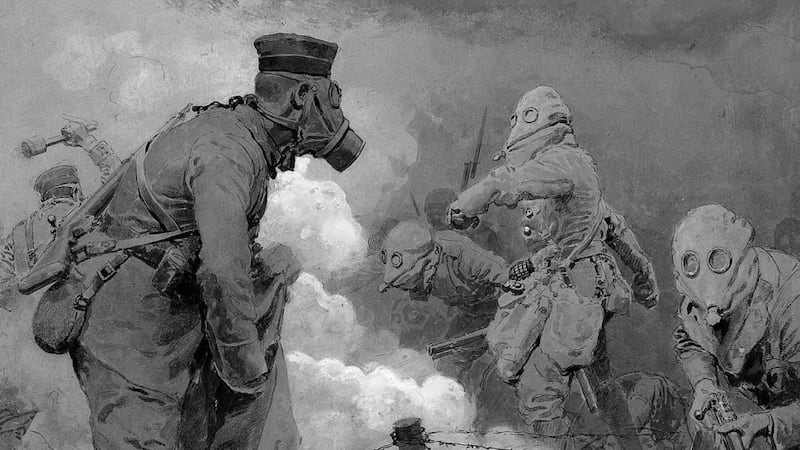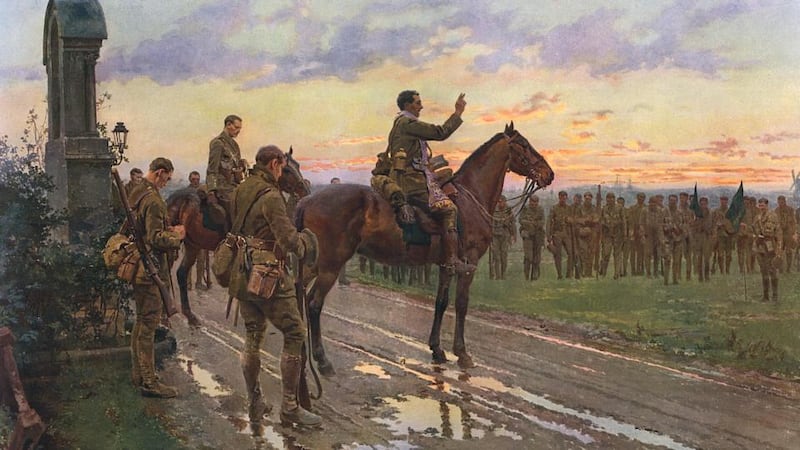The publication, earlier this month, of an image of the lost first World War painting, The Last General Absolution of the Munsters at Rue du Bois has rekindled memories among several older Irish Times readers.
The fate of the original painting, by Italian-born artist Fortunino Matania, remains unknown but prints of the painting, published in weekly newspapers a century ago, have survived.
The painting depicts soldiers of the 2nd Battalion, Royal Munster Fusiliers regiment receiving "general absolution" from their chaplain, Tipperary-born Fr Francis Gleeson, depicted in the painting on horseback, on the eve of battle in May 1915. Many of the men died within 24 hours including their commanding officer Lieut-Col Victor Rickard who is also depicted, on horseback. It is believed the painting was commissioned by his widow, Jessie Rickard. She returned to Ireland after the war and lived in the Montenotte, Cork home of a family friend, the historian and war veteran Denis Gwynn, who cared for her.


Fr James Good, a priest in Douglas, Cork now aged "over the 90 mark" said he "was on the staff of UCC in the 1950s" and was approached by Gwynn, then the university's Prof of Modern Irish History who "had a fervent Catholic invalid living in his home and she felt deprived of the Eucharist while the priest of her parish (St Patrick's, Cork) was on holidays". Fr Good regularly visited Mrs Rickard and recalls once asking how old she was on her birthday and said: "Mrs Rickard taught me a lesson which I have never forgotten: 'You don't ask a lady her age'".
Limerick native Joe Hardaker (87), who has a print of the Matania painting in his Co Clare home, said his father, also Joe Hardaker, had served with the 2d Battalion, Royal Munster Fusiliers on the Western Front and, after being wounded, was visited in Amiens hospital by Fr Gleeson. He has a photograph of the men together at the hospital and also "postcards from the trenches" sent home by his late father. Mr Hardaker himself joined the RAF. during the second World War when, aged "only 16", he used a Limerick cousin's birth certificate to confound recruitment staff in Belfast where he signed up.
David Bird of Cobh, Co Cork, whose father TH Bird was in 3rd Battalion, Royal Munster Fusiliers, also has a copy of the Matania print personally annotated with the "names of those in the foreground of the painting" by Col HS Jervis, the last Commanding Officer of the 2nd Munsters. The soldier in the front of the painting is Regimental Sgt-Major John Ring who was born in Bandon, survived the war, and died in Limerick in 1960. According to the Royal Munster Fusiliers Association, Ring "survived five consecutive years of fighting in France, refusing promotion time after time rather than leave the battalion and was highly respected by officers and men".
After seeing the photograph of the painting, Dr Ita Beausang of Clontarf said “it brought me back to 1955” when, then a music student at UCC, she was invited to a lunch at Prof Gwynn’s house in Montenotte” and met Mrs Rickard. The other guests included “Elizabeth Bowen [the writer], Eddie Sackville-West [a British music critic who became the 5th baron Sackville and lived at Clogheen, Co Tipperary], the Earl of Rosse and a London art dealer”. Mrs Rickard died, in Cork, in 1963 aged 86.
The mystery of what happened to the original painting seems to have gone with her to the grave. But happily, not all of Matania's work has been lost. The Naples-born artist, who moved to London in 1902 was, in addition to being an official first World War artist, also a renowned illustrator for The Sphere and The Illustrated London News – former weekly newspapers published in London.
His most famous and popular painting, Goodbye, Old Man, was commissioned in 1916 by the Blue Cross animal welfare charity, and shows a soldier bidding farewell to his fatally injured horse. It now hangs in the board room of the animal hospital in Victoria, London. More than one million horses saw service with the British Army during the first World War and the Blue Cross treated thousands.
Later this year, the English art researcher and historian Lucinda Gosling's Goodbye Old Man – Matania's Vision of the first World War, which features 100 images by the artist, will be published by The History Press.
Auction of illustations
Some of Matania’s original illustrations of the Great War for
The Sphere
and
The Illustrated London News
have also turned up at Christie’s auction house in London and will go under the hammer on October 8th.
Christie’s said “Poignantly they come to the market in the centenary of the War’s start and offer a fascinating insight to his first-hand experience of the front line” and that “Matania’s precise, photographic style with remarkable powers of observation meant that he had a unique ability to translate the fascinating historical events he witnessed with an unnerving realism”.
Among the black-and-white drawings are a terrifying image of a gas attack on British troops in the trenches and an image of women working in a munitions factory (each estimated at just £700-£1,000.
But the original of The Last General Absolution of the Munsters at Rue Du Bois' is not among the images consigned to the auction.
The search goes on.
Hollywood calls
Aside from his work during the first World War, Matania was also famous for his illustrations depicting the sinking of
Titanic
. He painted biblical scenes for Hollywood director Cecil B DeMille which inspired set designers for the film
The Ten Commandments
; and did illustrations of every major royal occasion in London from 1902 (the coronation of Edward VII) until 1953 (the coronation of Elizabeth II).
Fortunino Matania died, aged 81, in 1963, the same year as Mrs Rickard.












